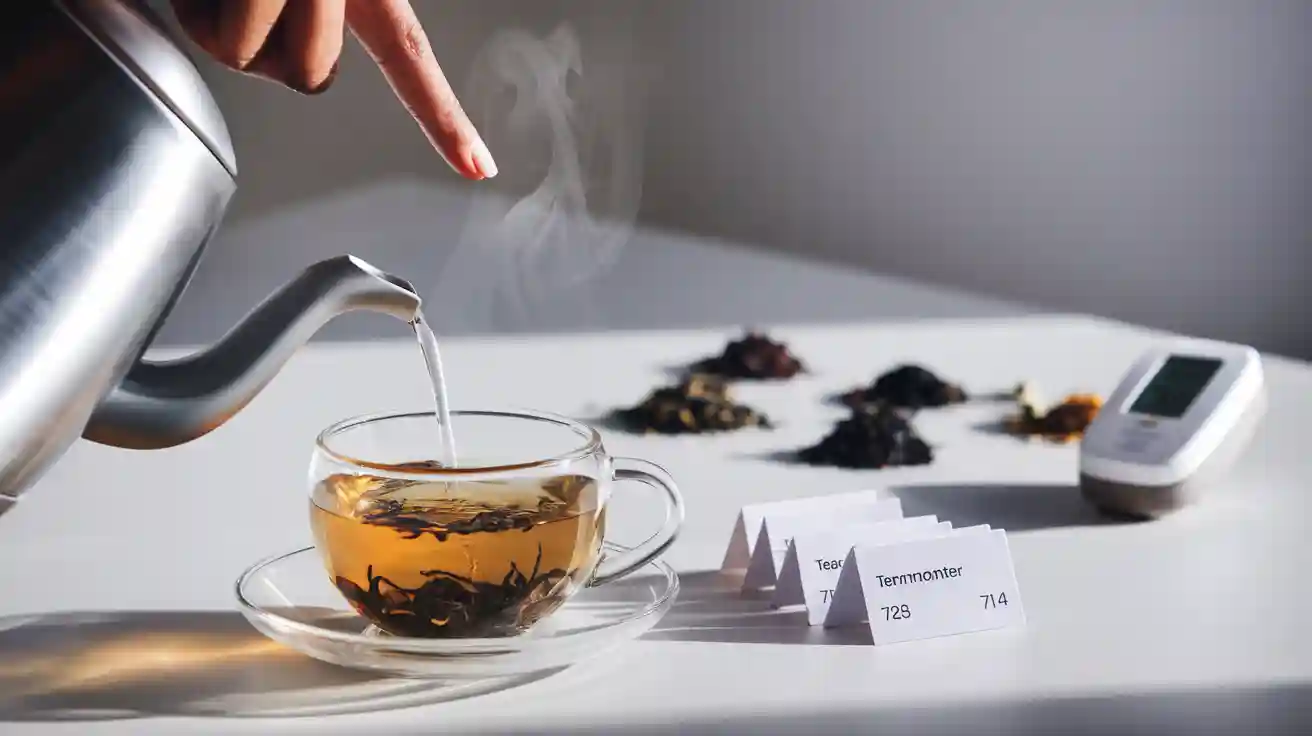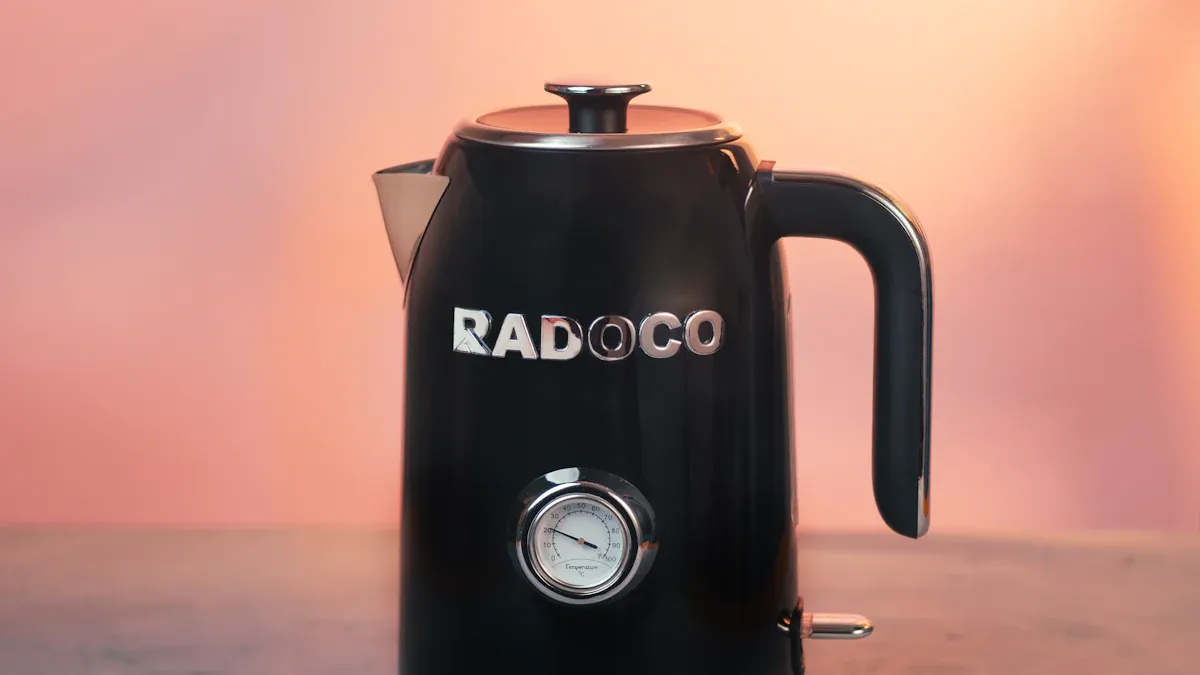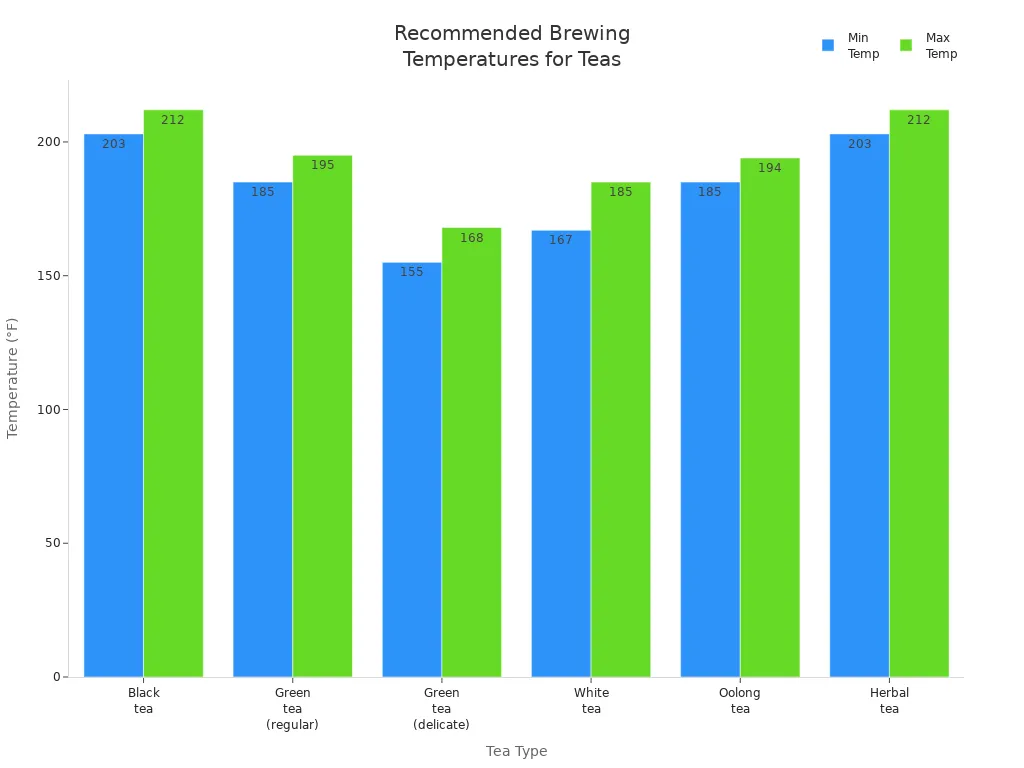
You unlock the full flavor of every tea by using the right water temperature. An electric kettle with temperature control gives you precision for brewing perfect tea every time. Many tea drinkers now choose these kettles because they make mastering tea temperature easy and consistent. This helps you enjoy better tea at home.
Why Different Temperatures for Different Teas Matter in Tea Brewing

How Water Temperature Impacts Tea Flavor
You might wonder why tea brewing needs such careful attention to tea temperature. Each type of tea contains unique compounds that release their best flavors at specific temperatures. When you use the right temperature, you help the tea leaves unlock their full potential. For example, green tea needs cooler water to keep its sweet and umami notes, while black tea requires hotter water for a bold, robust taste.
Here is a table that shows how different temperatures affect the extraction of flavors and compounds in several teas:
| Tea Type | Optimal Water Temperature Range | Key Extracted Compounds and Effects |
|---|---|---|
| Oolong | 85°C to 95°C (185°F to 203°F) | Efficient extraction of volatile organic compounds, amino acids, polyphenols; balances floral aroma and bitterness. |
| White | 75°C to 90°C (167°F to 194°F) | Lower temps preserve sweetness and floral notes; higher temps extract fuller flavors without too much bitterness. |
| Pu-erh | 95°C to 100°C (203°F to 212°F) | High temps extract polyphenols, caffeine, and aromatic alcohols for earthy, woody flavors. |
You can see that different temperatures for different teas lead to the best flavor extraction. This is true for both Japanese tea brewing and western style brewing.
Common Tea Brewing Problems from Incorrect Temperatures
If you use the wrong tea temperature, you may notice problems with flavor extraction. Here are some common issues tea drinkers face:
- Water that is too hot can burn tea leaves, causing bitterness and astringency.
- Green tea is very sensitive to high temperatures, which increases bitter compounds.
- Water that is too cool leads to weak or under-extracted tea with less flavor.
- Lower-quality teas become more bitter when brewed with overly hot water.
- Using water from dispensers set too low can result in under-extracted tea.
You can avoid these problems by using an electric kettle with temperature control. This helps you master tea brewing and enjoy every cup. Paying attention to optimal temperatures and extraction will make your tea taste better, whether you use Japanese tea brewing or western style brewing.
Step-by-Step Guide to Brewing Perfect Tea with an Electric Kettle with Temperature Control
Choose Quality Tea and Fresh Water
To start brewing perfect tea, you need to select high-quality tea leaves or tea bags and use fresh water. The quality of your tea and water will shape the flavor extraction and aroma in every cup. Here are some important criteria to help you choose:
- Pick the type of tea that matches your taste and health goals, such as black, green, oolong, white, or herbal.
- Choose tea bags made from paper, silk, or biodegradable materials. These options help preserve flavor and protect the environment.
- Look for packaging that keeps tea fresh and allows the leaves to expand during brewing.
- Check the recommended steeping time and flavor profile on the label.
- Think about your personal preferences, such as strength, caffeine level, and organic options.
You can also look at the tea leaves themselves. Fresh, high-quality tea leaves have a bright color, whole shape, and sometimes visible buds or tips. Loose-leaf tea often gives you a richer flavor extraction and more aroma than regular tea bags.
| Criterion | Description |
|---|---|
| Leaf Appearance | Size, shape, color, integrity, and presence of buds or tips indicate quality and freshness. |
| Freshness | Recent harvest dates and proper storage (airtight, protected from light, oxygen, moisture) are crucial to preserve flavor. |
| Processing Methods | Techniques like steaming, pan-firing, and baking influence flavor profiles and antioxidant content. |
| Packaging | Airtight containers, foil pouches, or proper barriers protect tea from degradation factors. |
| Ethical & Sustainable Practices | Organic cultivation, fair trade, sustainable packaging, water conservation, and social responsibility ensure quality and environmental care. |
| Grading | Presence of golden tips, aroma, and leaf quality grading systems help identify superior teas. |
| Benefits of Loose Leaf | Allows full leaf expansion, richer flavor, no fillers, and better aroma compared to tea bags. |
| Versatility | Loose leaf tea offers customization in brewing methods and a wider variety of tea types. |
Always use fresh, cold water for brewing. Avoid re-boiling water, as this can reduce oxygen and affect flavor extraction.
Select the Right Temperature for Your Tea
The right tea temperature is key to unlocking the best flavor extraction. Each tea type needs a specific temperature to bring out its unique taste and health benefits. For example, green and white teas need cooler water to protect delicate flavors and antioxidants. Black and herbal teas need hotter water for full extraction of robust flavors.
Brewing at the correct temperature helps you get the most antioxidants and beneficial compounds from your tea. If you use water that is too hot, you risk burning the leaves and making the tea bitter. If the water is too cool, you will not extract enough flavor or healthful compounds.
Tip: Using an electric kettle with temperature control gives you the precision needed for brewing perfect tea every time.
Quick-Reference Chart: Different Temperatures for Different Teas
You can use this chart to find the best tea temperature and extraction time for each tea type. This will help you achieve the perfect cup of tea and avoid common mistakes in tea brewing.
| Tea Type | Temperature Range (°F) | Steeping Time |
|---|---|---|
| Green Tea | 155-180 | 1-3 minutes |
| Black Tea | 203-212 | 2-4 minutes |
| Oolong Tea | 185-194 | 3-4 minutes |
| White Tea | 167-185 | 1-3 minutes |
| Herbal Tea | 203-212 | 5+ minutes |
| Chai Tea | 208-212 | 5 minutes |
| Pu-erh Tea | 185-208 | 3 minutes |
| Jasmine Tea | 185 | 2 minutes |
| Rooibos Tea | 203-212 | 2-3 minutes |

This chart helps you set your electric kettle with temperature control to the right setting for each tea. Following these guidelines ensures you get the best flavor extraction and health benefits.
Use the Electric Kettle’s Temperature Control Settings
An electric kettle with temperature control lets you set the exact tea temperature you need. Leading brands offer precise settings, often accurate within 1°F. Some kettles use dials, while others use buttons or presets for different tea types. You can rely on these kettles for consistent results and easy operation.
| Brand & Model | Temperature Control Type | Accuracy (Deviation) | Keep Warm Duration | Control Interface | Capacity (oz) | Notes on Reliability & Ease of Use |
|---|---|---|---|---|---|---|
| Fellow Corvo EKG Electric Kettle | Variable (Dial) | Accurate (~±1°F) | 60 minutes | Dial (push & turn) | 30 | Wide temp range (104°F-212°F), longest keep warm, slower boil time |
| Breville Variable Temp Luxe | Variable (Buttons) | Accurate (~±1°F) | 20 minutes | Button presets | 57 | Easy to use, quick boil, shorter keep warm, higher price |
| OXO Brew Adjustable Temp Kettle | Variable (Dial) | Accurate (~±1°F) | N/A | Dial | Large | Affordable, simple dial, good accuracy |
| Bodum Bistro | Variable | Off by ~10°F | N/A | N/A | N/A | Poor temperature accuracy |
| Fellow Clyde Electric Kettle | Non-variable (Boil only) | N/A | No | Simple tab | 51 | Reliable, simple, no temperature control |
Note: Always check your kettle’s manual for instructions on setting the right temperature for your tea.
Measure Tea and Water Accurately
Accurate measurement of tea and water is important for flavor extraction and a perfect cup of tea. Too much tea or too little water can make your tea too strong or bitter. Too little tea or too much water can make it weak and bland.
| Tea Type | Recommended Tea-to-Water Ratio (grams per 100ml) | Notes on Flavor Extraction and Adjustment |
|---|---|---|
| Green Tea | 2 to 3 grams | Balanced flavor; delicate, may need slight adjustment to avoid overpowering |
| Black Tea | 2 to 3 grams | Can handle more leaf material without becoming overpowering |
| Oolong Tea | Approximately 5 grams | Complex flavors benefit from higher leaf quantity |
A standard ratio is about 2 grams of tea per 8 ounces (240ml) of water. For larger amounts, scale up the ratio. Delicate teas like green or white may need small adjustments. Always experiment to find your favorite strength.
- If you use too much tea, you risk over-extraction and bitterness.
- If you use too little tea, you get weak extraction and less flavor.
- Brewing in a full cup gives you stronger tea, as more compounds dissolve.
Steep for the Recommended Time
Extraction time is just as important as tea temperature. Each tea type has an ideal steeping time for the best flavor extraction. Over-steeping increases bitterness and astringency, while under-steeping leads to weak flavor and poor extraction.
| Tea Type | Recommended Steeping Time | Recommended Water Temperature |
|---|---|---|
| Green | 1 to 2 minutes | 175-180°F (steaming briskly) |
| Black | 3 to 5 minutes | 212°F (full boil) |
| Oolong | 2 to 3 minutes | 195°F (almost boiling) |
| White | 2 to 3 minutes | 175-180°F (steaming briskly) |
| Herbal | 5 or more minutes | 212°F (full boil) |
Tip: Set a timer to avoid over-steeping. This helps you control extraction time and get a perfect cup of tea every time.
If you over-steep, you will notice more tannins, which cause bitterness and a dry mouth feel. Under-steeping will not extract enough flavor or antioxidants.
Serve and Enjoy
Serving your tea the right way helps preserve its flavor and aroma. Tea professionals recommend these steps for brewing perfect tea:
- Use porcelain or ceramic teapots and cups to keep the flavor pure.
- Warm your teapot before brewing to help with flavor extraction.
- Pour the tea as soon as it finishes steeping to avoid over-extraction.
- Add milk last if you like, but only after tasting the tea on its own.
- Enjoy your tea in a calm, clean space to focus on the aroma and taste.
Note: Japanese tea brewing often uses small cups and careful pouring to highlight the tea’s aroma and flavor.
With these steps, you can unlock every tea’s flavor and enjoy a perfect cup of tea every time. Using an electric kettle with temperature control gives you the precision needed for consistent results, whether you love green, black, oolong, or herbal teas.
Tips and Troubleshooting for Mastering Tea Brewing with an Electric Kettle
Practical Tips for Using an Electric Kettle with Temperature Control
You can get the best results from your electric kettle by following a few expert tips.
- Clean and descale your kettle regularly with vinegar or a commercial descaler. This prevents limescale buildup and keeps heating fast.
- Use filtered water to reduce mineral deposits and improve the taste of your tea.
- Never boil the kettle when empty. This protects the heating element.
- Set the kettle to the exact temperature needed for your tea. Heating only to the required temperature saves energy and avoids overheating.
- Always follow the manufacturer’s cleaning and maintenance instructions.
- Check the kettle’s cord and seals for damage. Replace parts if needed to keep your kettle safe.
- Store the kettle upright with the lid open to prevent odors and moisture buildup.
Tip: Stainless steel kettles last longer and keep heat better, making them a smart choice for daily tea brewing.
Troubleshooting Common Tea Brewing Mistakes
Many people make simple mistakes when brewing tea. You can avoid these problems by paying attention to a few details:
- Guessing the temperature or extraction time often leads to poor flavor. Always use your kettle’s controls and a timer.
- Using water that is too hot or too cold affects extraction. For example, boiling water can make green tea bitter.
- Over-steeping increases bitterness by releasing too many tannins. Under-steeping gives weak flavor and poor extraction.
- Using too much or too little tea changes the strength and extraction of your drink.
- Not cleaning your kettle or tea tools can leave residues that spoil the taste.
If your kettle does not heat properly, check the power supply and clean out any scale. Replace damaged parts if needed.
Experimenting to Find Your Perfect Cup
You can adjust your brewing method to match your personal taste. Try changing the water temperature, extraction time, or the amount of tea leaves.
| Variable | How to Experiment | Impact on Extraction and Flavor |
|---|---|---|
| Water Temperature | Raise or lower for different teas | Changes which compounds are extracted |
| Extraction Time | Steep longer or shorter | Affects strength and bitterness |
| Leaf Quantity | Use more or fewer leaves | Alters flavor depth and extraction |
Start with recommended settings, then make small changes. Keep notes on what you like best. Over time, you will discover the perfect extraction and flavor for every tea.
You can enjoy delicious tea every time by mastering your electric kettle’s temperature control. Using the right temperature for each tea unlocks unique flavors and aromas. This process helps you create a perfect cup of tea and transforms your tea-drinking experience into a mindful ritual that brings calm and focus.
FAQ
What makes an electric kettle with temperature control better for brewing tea?
You get precision with an electric kettle with temperature control. This helps you use optimal temperatures for different teas and improves flavor extraction in every cup.
Can I use loose-leaf tea with an electric kettle with temperature control?
Yes, you can use loose-leaf tea. You control tea temperature and extraction time, which helps you unlock the best flavor extraction and enjoy a delicious tea-drinking experience.
How do I avoid bitterness when brewing perfect tea?
You avoid bitterness by mastering tea temperature and extraction time. Use high-quality tea leaves, set the right temperature, and follow the recommended steeping time for each tea.


